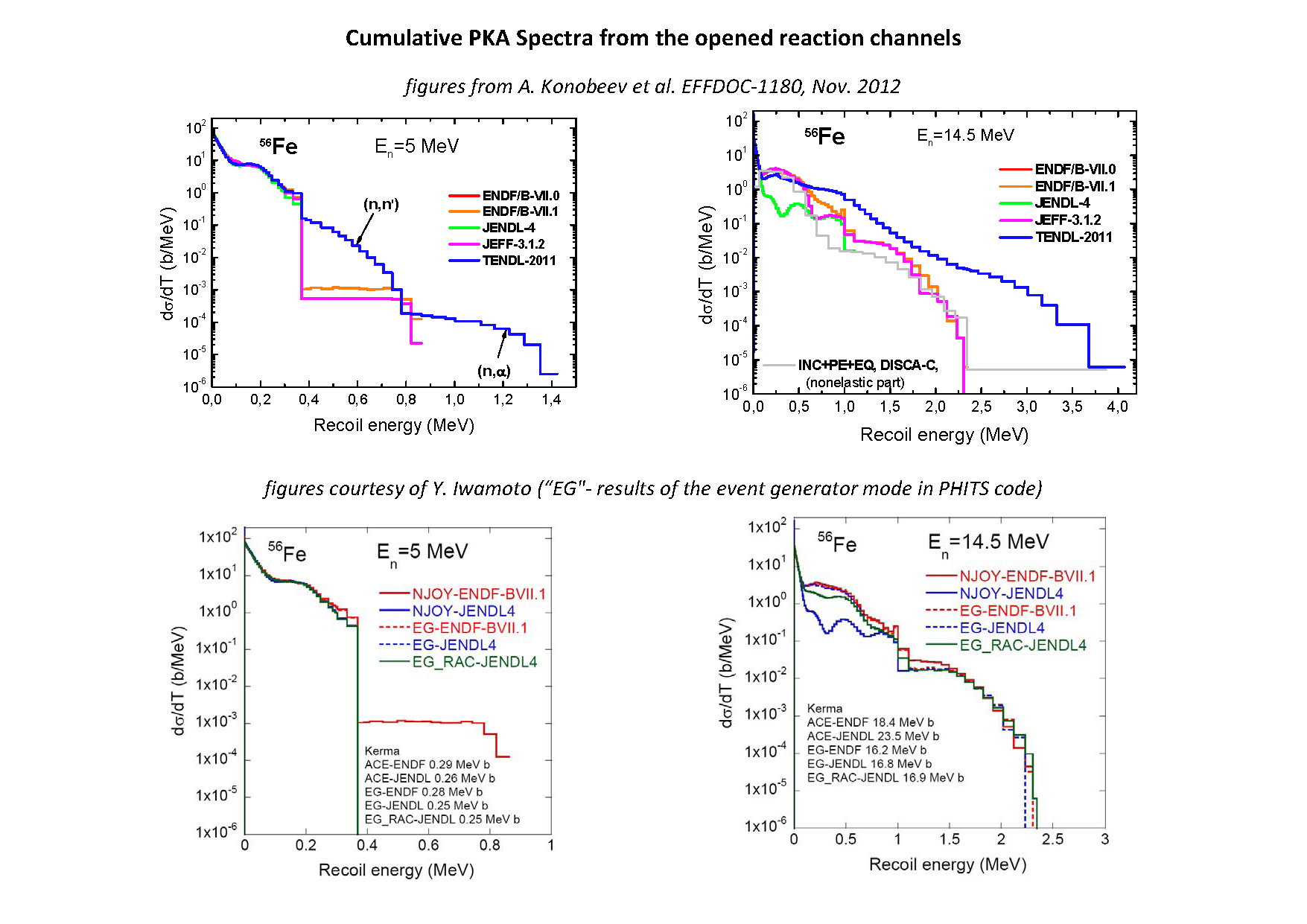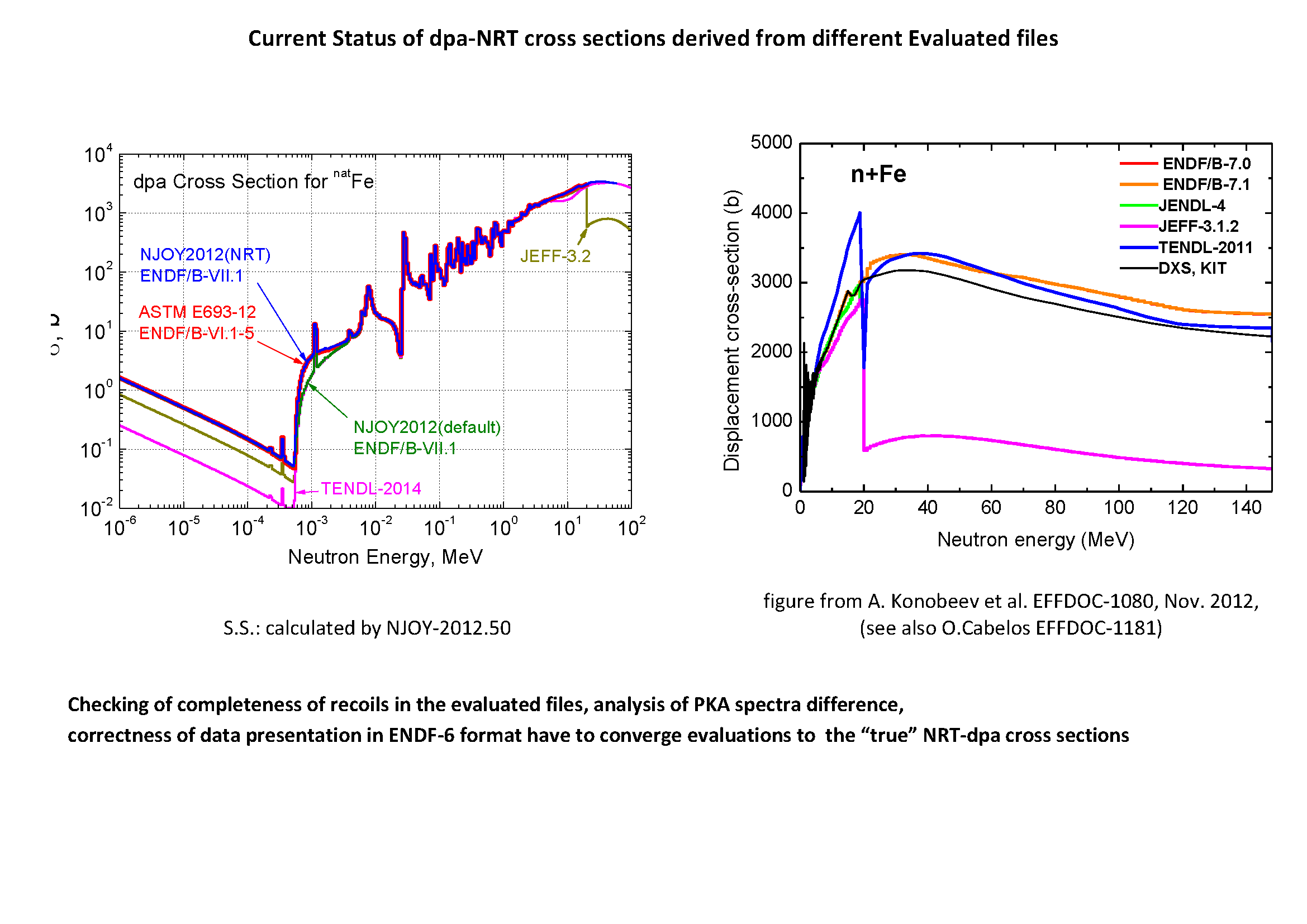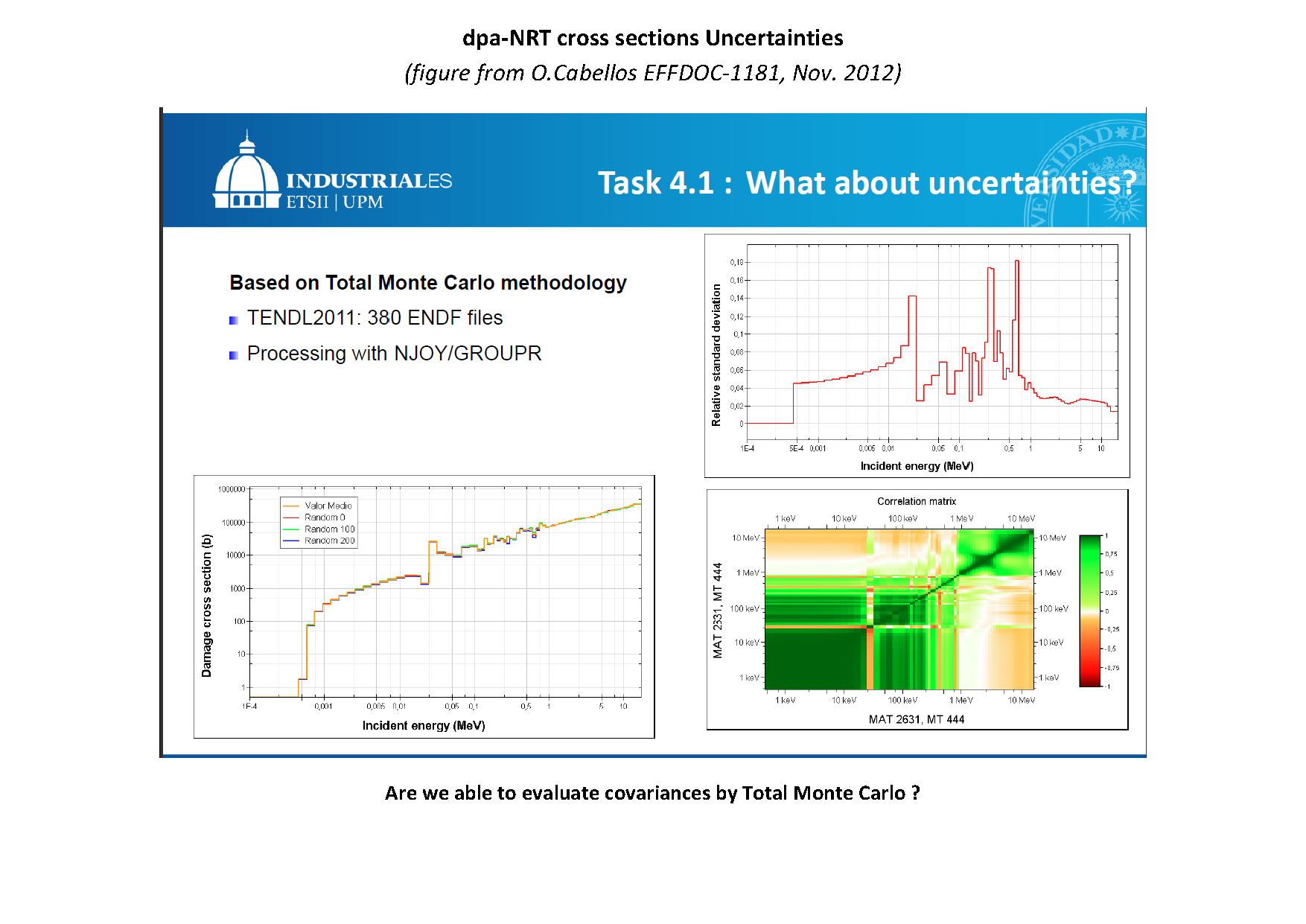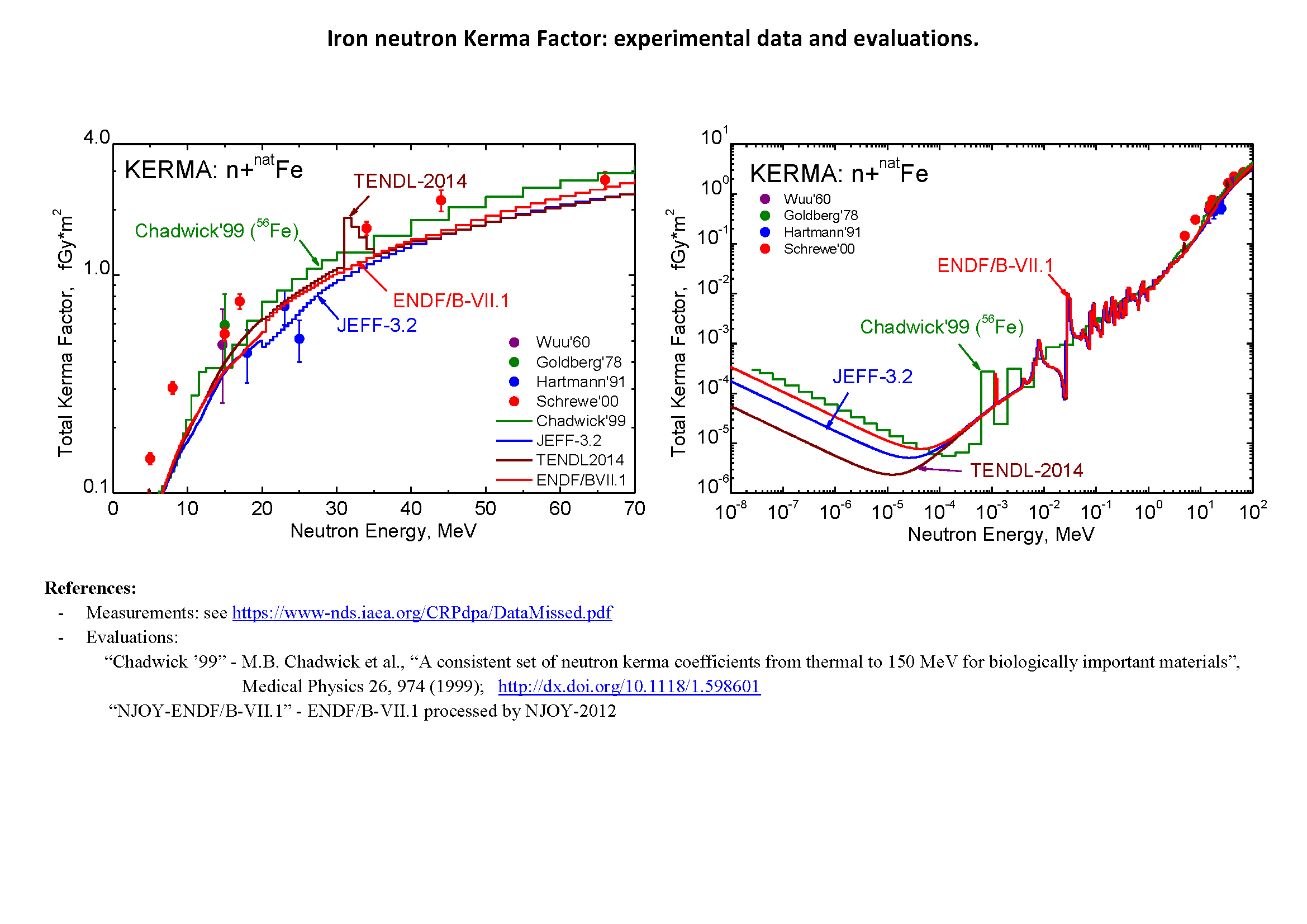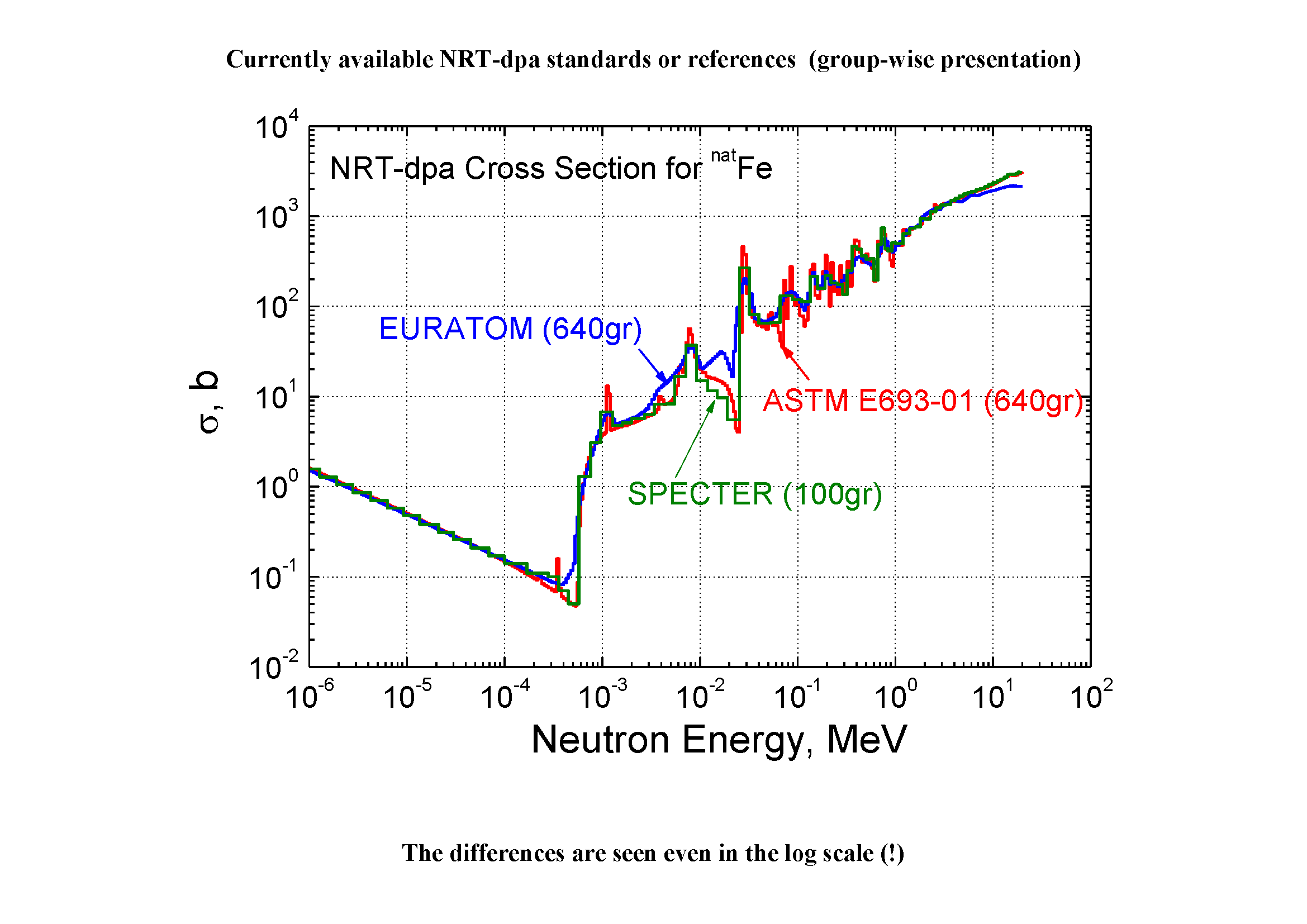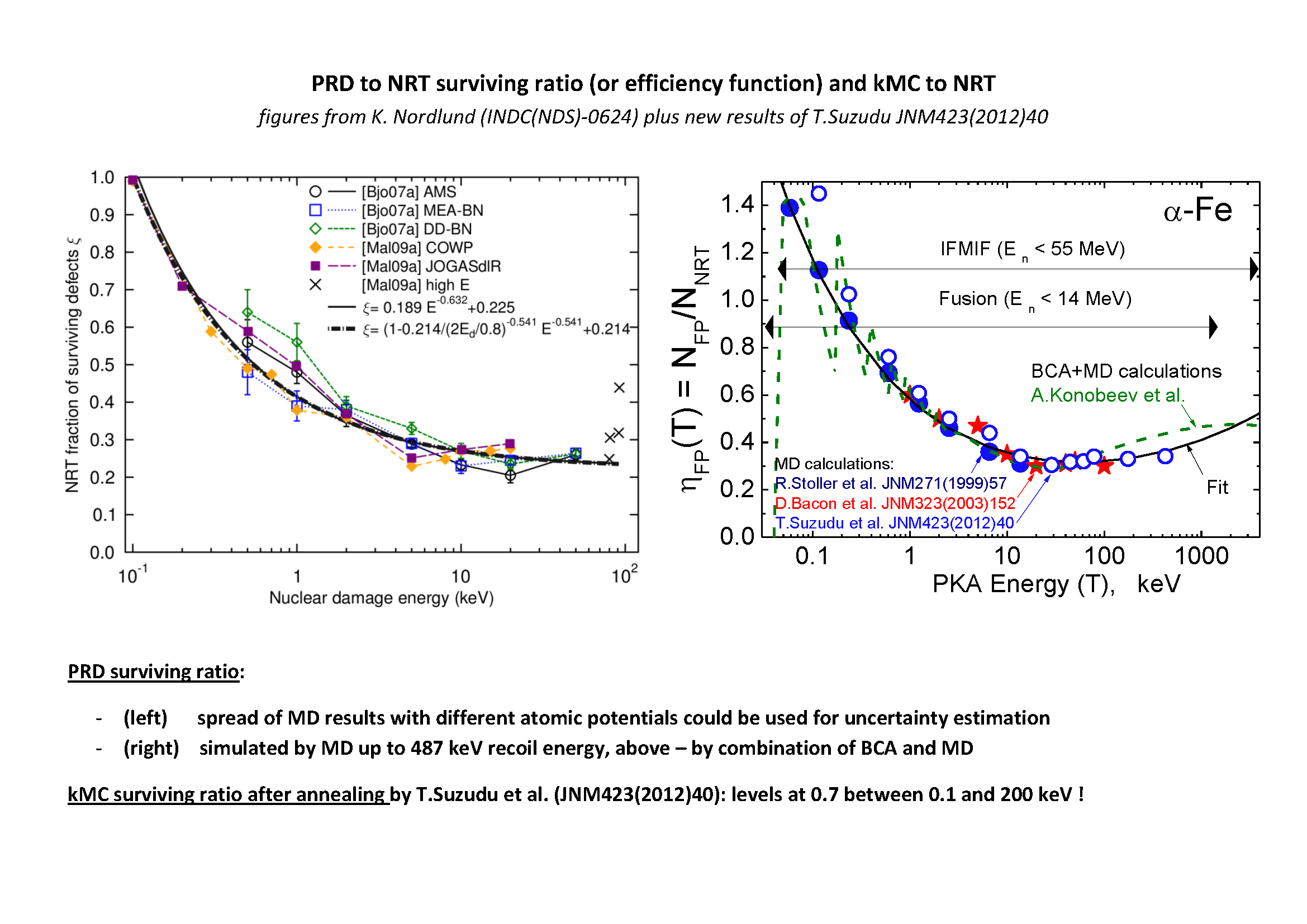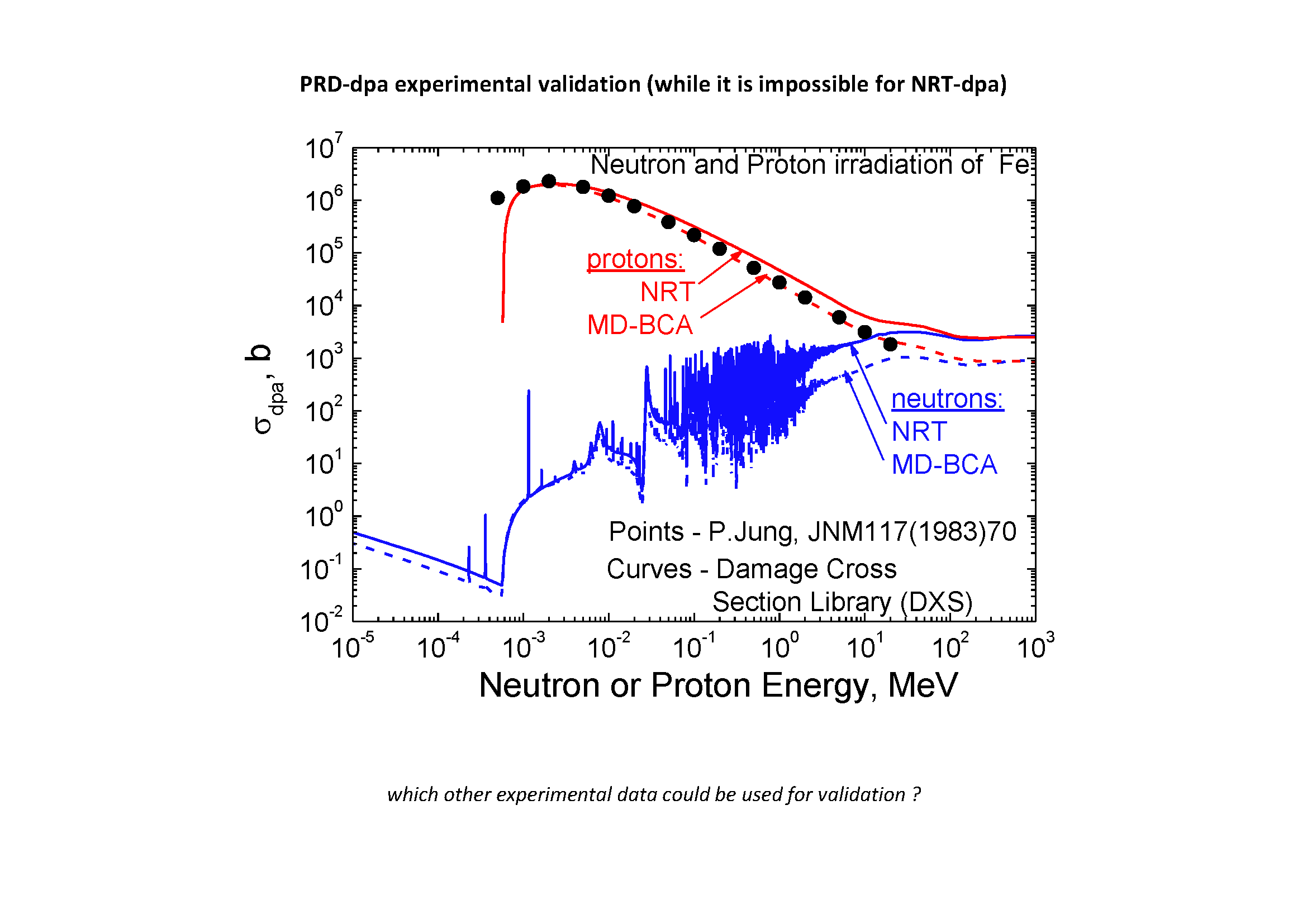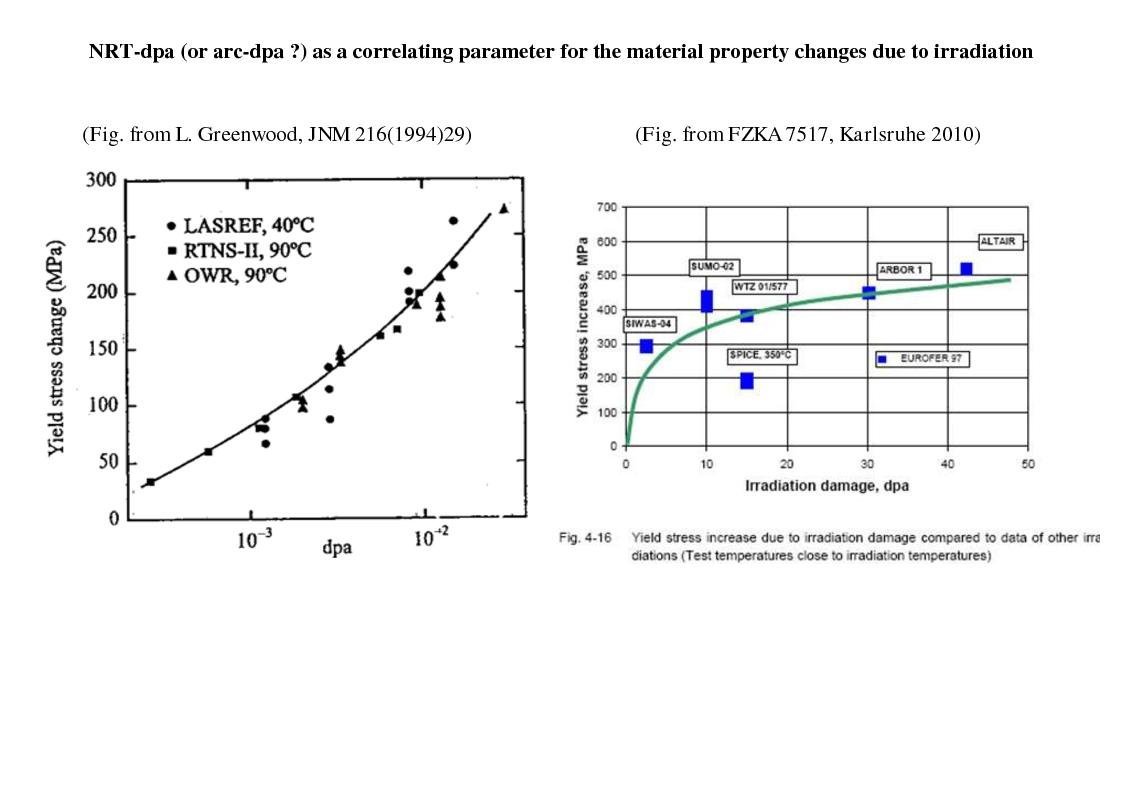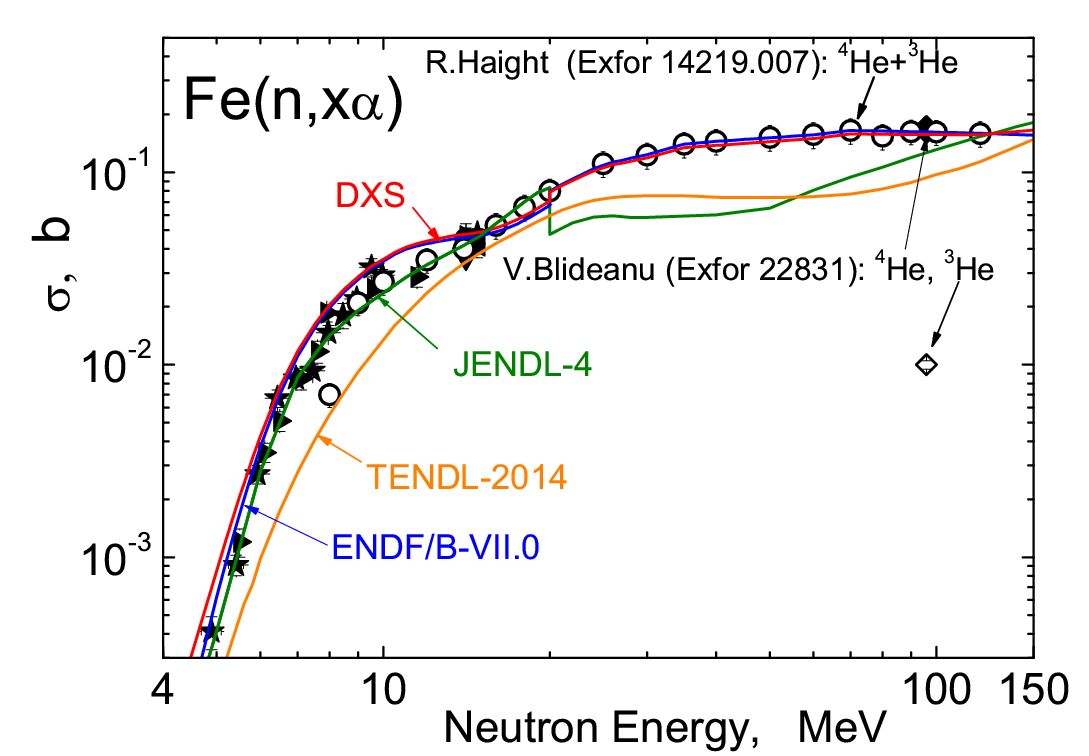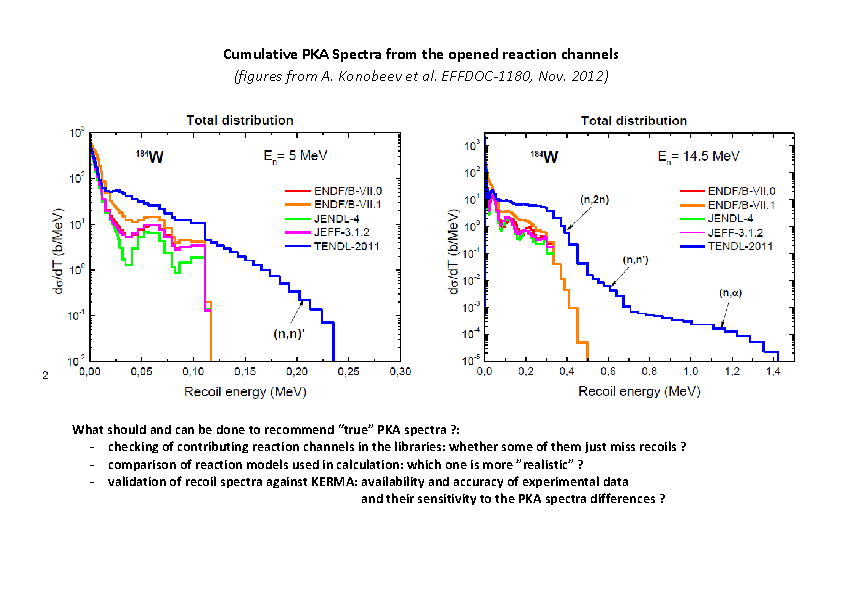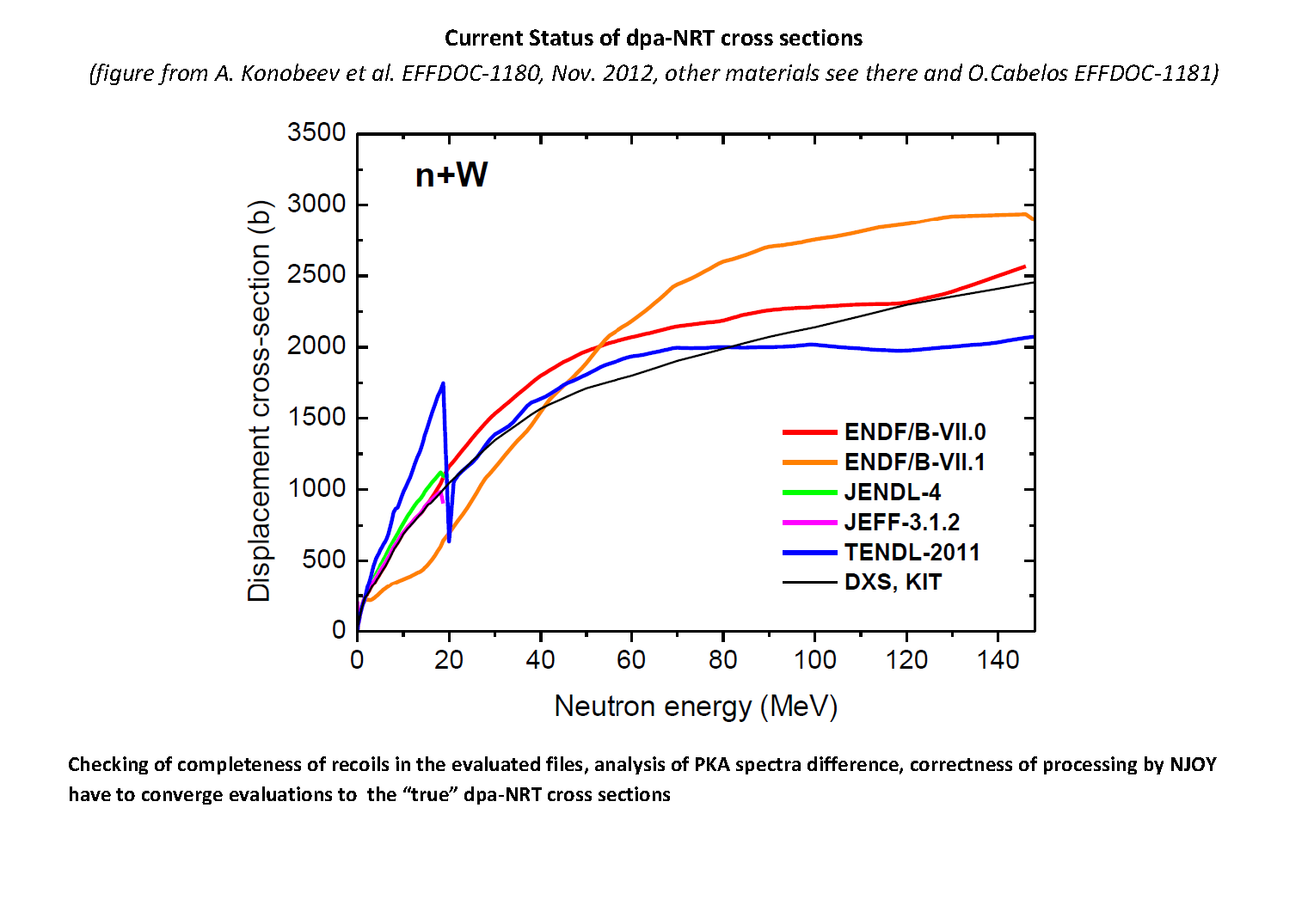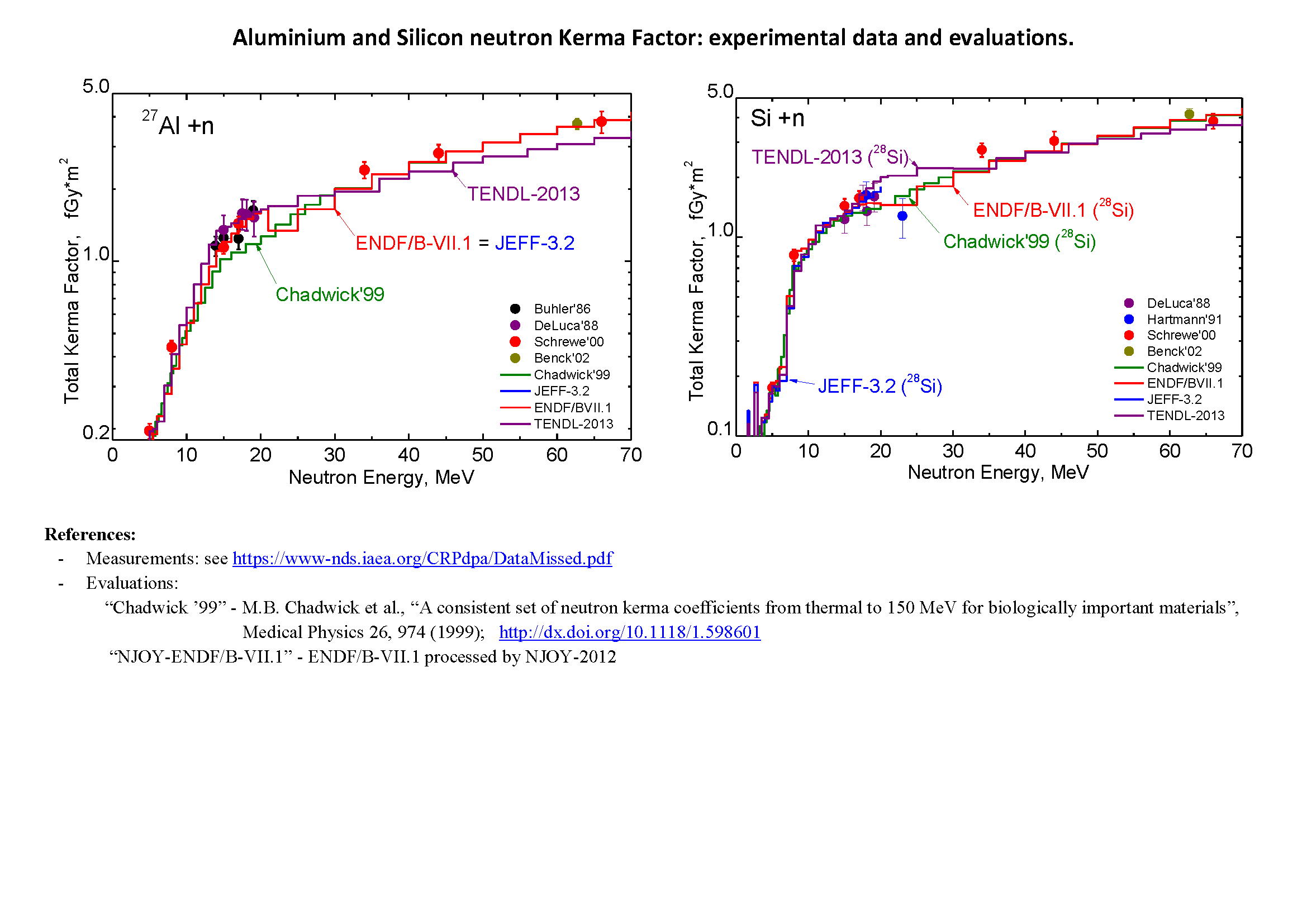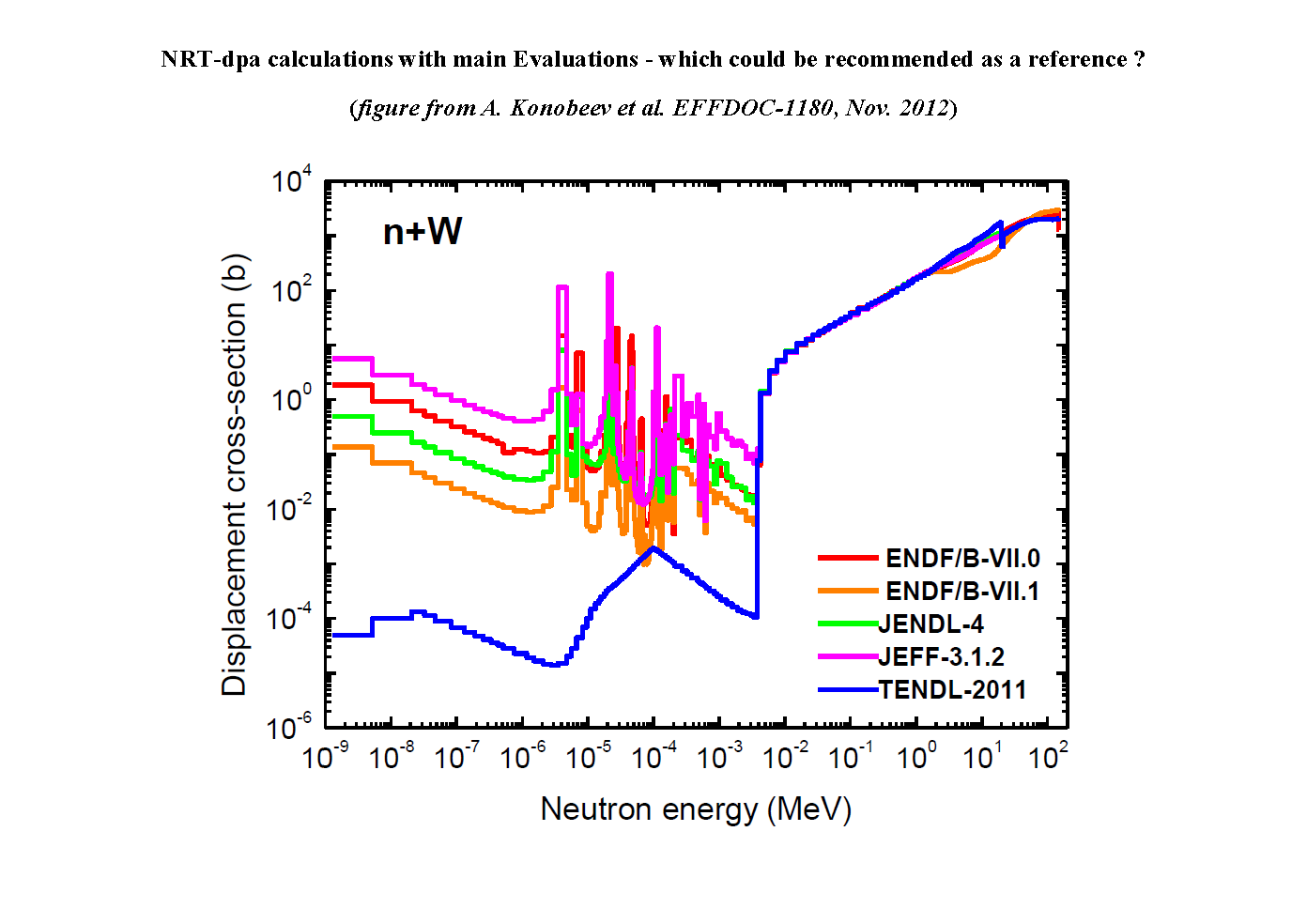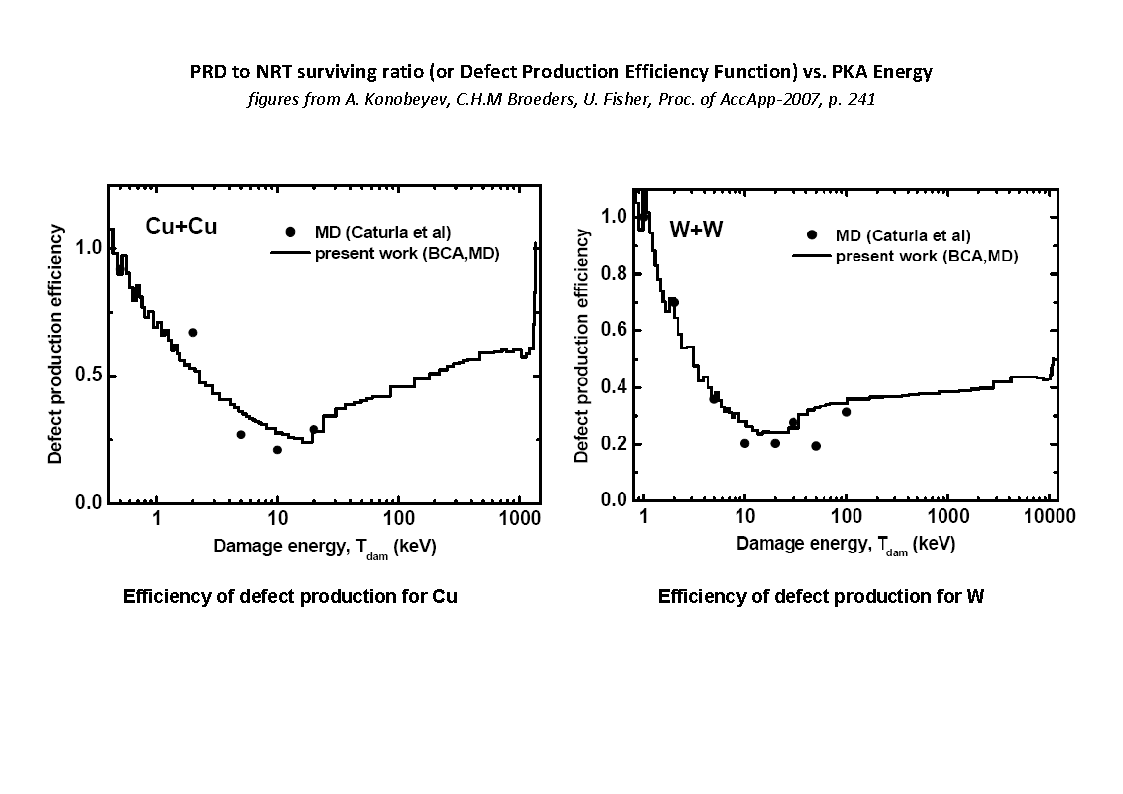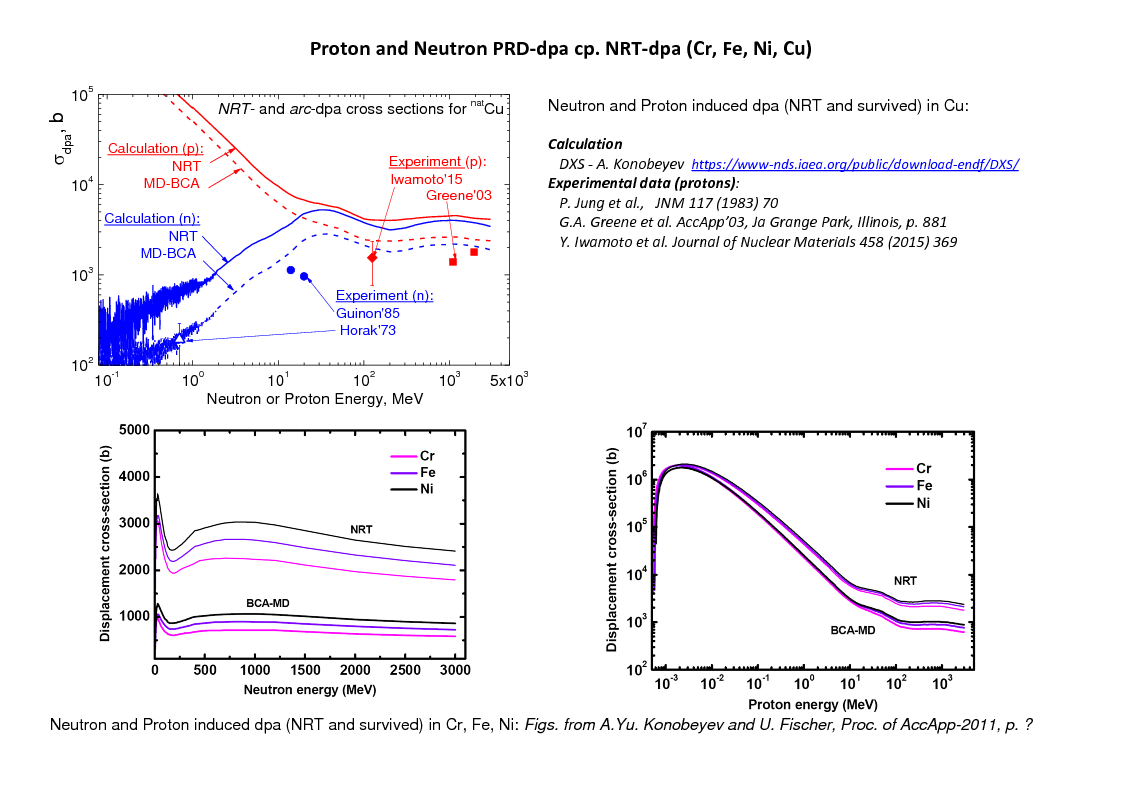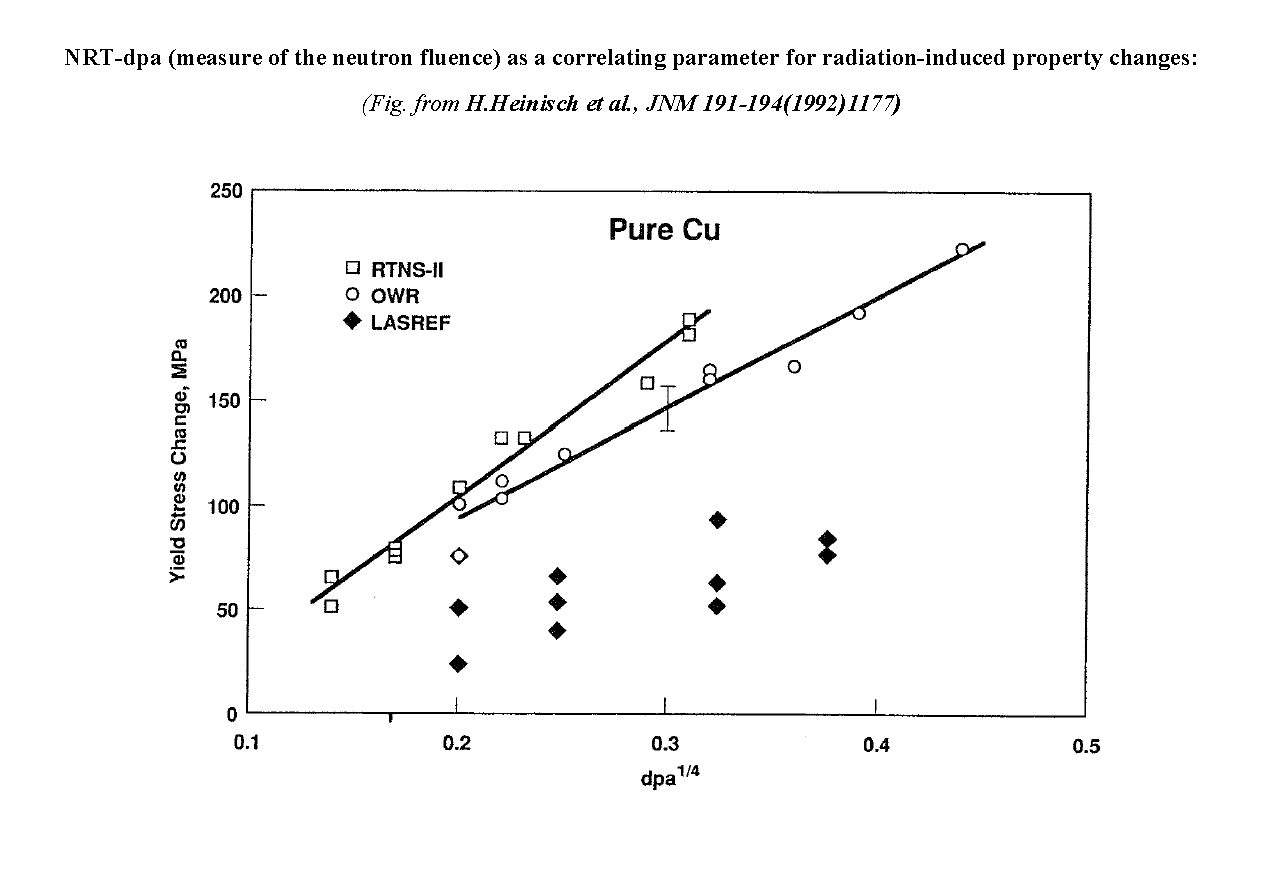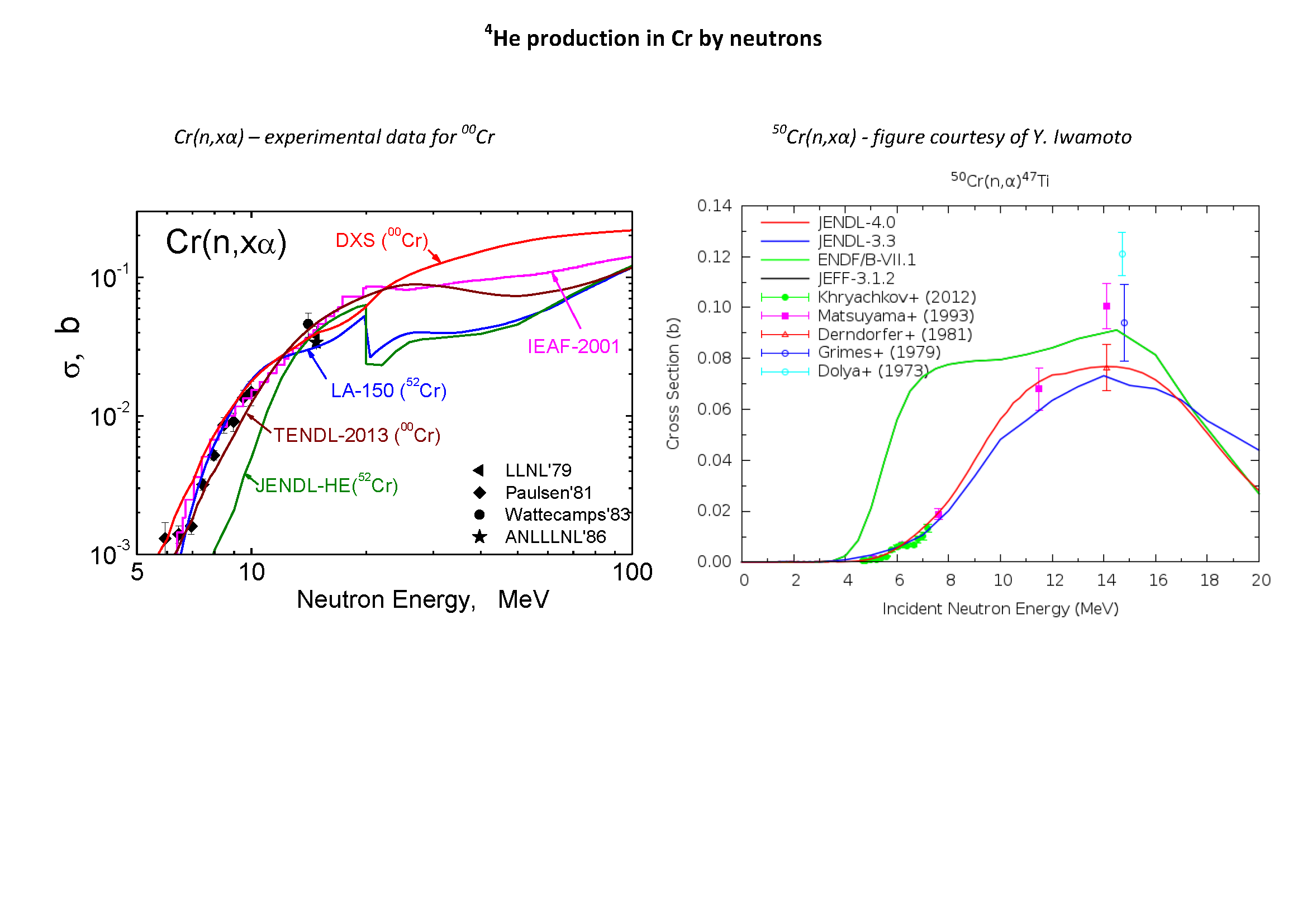Primary Radiation Damage Cross Sections
duration 4 years, from Nov 2013 (1st RCM) - June 2015 (2nd RCM) - October 2017 (3rd RCM)
(initiated according the recommendations of Technical Meeting 1-4 Oct 2012)
supplemental Technical Meeting 13-16 June 2016
Scientific background, objectives
Nuclear interactions can be the source of atomic displacement and post-short-term cascade annealing defects in irradiated structural materials. Such quantities are derived from, or can be correlated to, nuclear kinematic simulations of primary atomic energy distributions spectra and the quantification of the numbers of secondary defects produced per primary as a function of the available recoils, residual and emitted, energies. Recoils kinematics of neutral, residual, charged and multi-particle emissions are now more rigorously treated based on modern, complete and enhanced nuclear data parsed in state of the art processing tools. Defect production metrics are the starting point in this complex problem of correlating and simulating the behaviour of materials under irradiation, as direct measurements are extremely improbable. The multi-scale dimensions (nuclear-atomic-molecular-material) of the simulation process is tackled from the Fermi gradation to provide the atomic- and meso-scale dimensions with better metrics relying upon a deeper understanding and modelling capabilities of the nuclear level. Detailed, segregated primary knockon- atom metrics are now available as the starting point of further simulation processes of isolated and clustered defects in material lattices. This allows more materials, incident energy ranges and particles, and irradiations conditions to be explored, with sufficient data to adequately cover both standard applications and novel ones, such as advanced-fission, accelerators, nuclear medicine, space and fusion. This CRP reviews the theory, describes the latest methodologies and metrics, and provides recommendations for standard and novel approaches.
The Coordinated Research Project aimed at reviewing the theory, methodology and data-streams behind the ubiquitous 70's Norget- Robinson -Torrents-dpa material damage-dose-defect energy based metric, including its short-comings. Furthermore, the project aimed to evaluate and explore alternative, modern and enhanced metrics that (theoretically) could be better able to highlight the complex problem of correlating, simulating and predicting the behaviour and evolution of materials properties when under particle irradiation. Outcomes from the CRP, discussed below, include revised, improved, extended numerical databases and metrics useful for the simulation of particle-induced defect production (both isolated, point defects, and defect clusters) as a function of the particle energy and spectra and not just for the well-trodden thermal-neutron energy range and standard materials of the fission industry. The actual modelling has focussed on methods of determining defect production cross-sections (DPCS) from primary knock-on atoms (PKA) simulations and recoil energy-dependent defect production function derived from experiments. However, these rarely explore beyond core elements, such as iron and silicon, in low-energy irradiation fields. Emphasis was also put on uncertainty and sensitivity analyses, as well as on nuclear-atomic-molecular-material scaling effects and their even more complex possible interpretations. Examples of DPCS simulations are presented, applicable to a large number of elements, irradiation fields, conditions and defect types in the neutron energy range from thermal to tenths of MeV. These simulations include improved treatment of non-elastic multi-particles events while elastic and inelastic scattering events are treated based on much refined cross-sections angular distribution and emitted spectra data. Alternatives and limits to the secular NRT-dpa approaches, including prompt, time-dependent and decay-induced defects, are also discussed.
The simulation of neutron-induced radiation damage in materials is complicated by competing displacement events and nuclear-reaction effects. Fortunately, in the structural materials used in existing fission applications the dominant driver seems to be displacement damage from elastic events, as opposed to non-elastic, which generally only slowly (in time) results in lasting changes to materials due to the high rate of recombination. This explains why the defect production cross-section metric based on damage energy, which leads to the displacement per atom (dpa) measure, has been successful in correlating radiation effects in those (iron-based) materials under different irradiations environments thermal, mixed or fast, neutrons and ions allowing the results to be sensibly compared. However, there is little basis and no experimental evidence that the others effects, mostly occurring in the fast regime or ion accelerator environments where non-elastic events dominate, can still be considered as secondary or negligible. It is clear that the earlier nuclear damage databases did not cater for those considerations. In some non-iron based structural materials transmutation due to thermal neutron (n,γ) and/or (n,α) and (n, p) reactions can be significant, and in all materials where the non-elastic events have a significant impact (above a few hundreds keV incident neutron energy) there can be non-negligible secondary events or consequences. The simple correlation between defect productions and recoil damage energy is then invalid because the recoil atom is not of the same element, nucleon away; the emitted charged particle is in the MeV energy range; most event scattering law are highly anisotropic; the target is a compound, non-metallic, etc. Transmutation changes the composition of materials with time, and this can significantly modify the carefully crafted original material engineering properties. Consequently, the characterization of radiation damage in materials must take into account transmutation as well as displacement damage metrics from non-elastic events to properly predict the evolution of radiation damage in materials in the different technologies: space, fusion, accelerator, novel fission, etc. In those cases the PKAs of the often radioactive transmuted elements, energy/angle-dependent multiple emitted particles, gas production, break-up and decay-emission events need to be also considered to properly and physically simulate the time-dependent changes in material properties under challenging irradiation conditions.
Executive summary and outputs
Progress in data provision at the nuclear scale, assuming that the general purpose nuclear data file are fit to the tasks (of sufficient completeness to capture all relevant processes particularly at high energy), is a step forward in the proper understanding of material defect metrics induced by radiation but this is very small step with regard to the seamless integration of the models across the length (nm - µm - mm - m) and time (ps - µs - ms - s) scales into one coherent modelling framework. Fundamentally, the above leads to the conclusion that a simple integral measure such as dpa (NRT, arc, or other) is not sufficient, even though it may be a good first order estimate, to fully capture the damage metrics from complex irradiation more substantial methodologies and algorithms from the nuclear-reaction space (as described in this paper, and allowing uncertainty quantification and propagation) to the molecular-material ones must be included in complete plant and material modelling. At the same time, the historical correlative benefits of integral measures must be acknowledged and their continued inclusion as a metric if only as a cross-comparison to historical data and work necessitates the continued development and improvement of metrics relevant to material evolution under irradiation and defect production cross-section. However, in this latter case, the improvements must accept the limitation and not deviate too significantly from the comparative and correlative benefits of the NRT-dpa original, as stated by its founders.
- NJOY-2016 pointwise data forms of heating kerma (kinetic energy release in material), NRT-dpa damage energy and gas production metrics for up to 83 elements from: TENDL-2019 - JENDL-4.0 - ENDF/B-VIII.0
- Graphical comparison plots : TENDL-2019 versus ENDF/B-VIII.0 - TENDL-2019 versus JENDL-4.0 - ENDF/B-VIII.0 versus JENDL-4 (when the response exists in both sources)
- NJOY-2016 groupwise isotopic and elemental recoils and emitted particles PKA spectra here but also here
- Reference application fields experimental, simulated spectra
- Eur. Phys. J. Plus (2019) 134: 350 Neutron-induced damage simulations: Beyond defect production cross-section, displacement per atom and iron-based based metrics here
- CRP generated relevant publication articles
Specific issues addressed
- SPECTRA-PKA is a modern open-source command-line driven programme for calculating the expected primary knock-on atom (PKA) spectra for a given target nuclide under neutron or charged particle irradiation. NJOY-2016 processed recoil matrices must be provided as the input nuclear data for each nuclide and reaction channel of interest. SPECTRA-PKA will read the nuclear data and collapse the data for each reaction channel in a file with a user-defined energy spectrum of incident particles. SPECTRA-PKA outputs the resulting PKA spectra for each reaction channel read-in, as well as summed PKA distributions for each different recoiling nuclide or element, including both the typically heavy residuals and the secondary-emitted light gas particles. Crucially, SPECTRA-PKA has the ability to process data, in a single run, for a complex material containing many different target species.
- Novel dpa metrics such as the arc-dpa- and rpa-equations, not intended to replace the NRT-dpa, which is still valid as a convenient energy deposition unit and is useful for applications such as comparing different kinds of irradiations, can be proposed as alternative if one wishes to have a somewhat differemt estimate of the actual damage production or number of replaced (mixed) atoms. (see RCM-2 Report INDC(NDS)-0691 ).
- PKA spectra:
- availability in libraries, methods of calculation, agreement and uncertainties
Sample input to produce PKA matrices by NJOY-99 up 55 MeV. Then PKA spectra can be extracted from NJOY output at one neutron Energy or fold with n-Spectrum by code SPKA-6C (this is essentially upgraded version by A.Konobeev, who included surviving function for Fe, weighting of PKA spectra by damage energy ...)
- Examples of Documentation and Numerical Data:
> PKA distributions of the elements simulated using TENDL-2014 in Fusion Plants: Report CCFE-R(15)-supplement
> PKA spectra for 22 Elements extracted from major Libraries by Y.Iwamoto: Plots - KERMA/DamageEnergy/dpa:
- processing of Evaluated cross section files and comparison with Experiment: Evaluations vs. Measurements
- dpa calculations by different codes: SRIM vs. DXS (proton induced NRT-dpa)
- plots by NJOY-2012 (sample input), ENDF/B-VII.1:
7Li, 9Be, 000C, 16O, 27Al, 28Si, 48Ti, 52Cr, 55Mn, 56Fe, 58Ni, 63Cu, 90Zr, 184W, 238U ...
- problems observed by processing of ENDF/B-VII.1 by NJOY-2012.50 and comparing with ASTM E693-12 standards
- calculation of observables for Element from Isotopes by NJOY-2012.50: input (you have to modify the beginning of the tape 90, generated by MIXR, like: this)
the most correct way at the moment: run NJOY-2012.50 (with additional upxxx from S.Kahler) with THIS INPUT
- KERMA, heating and dpa-CS: status and problems observed during processing of major evaluations by:
Y.Iwamoto - comparison of PHITS with JENDL-4.0, ENDF/BVII.1, TENDL-2014 for 28Si, 56Fe, 184W (Plots),
C.Konno - intercomparison of JENDL-4.0, ENDF/BVII.1, JENDL-3.1b for 498 isotopes (NRT-dpa and KERMA),
J.Conlin et al. - presentation at CSEWG-2013 (here) - neutron induced Gas (helium, hydrogen) production cross sections:
- plots by NJOY-2012 (sample input), ENDF/B-VII.1:
7Li, 9Be, 000C, 16O, 27Al, 28Si, 48Ti, 52Cr, 55Mn, 56Fe, 58Ni, 63Cu, 90Zr, 184W, 238U ...
- processing of Evaluated cross section files and comparison with Experiment: Evaluations vs. Measurements
- proton induced Gas (helium, hydrogen) production cross sections:
- at intermediate energies 62 - 1200 MeV (KIT Report 7660, 2014) - Uncertainties/covariances for these quantities:
- basic/partial cross section covariancies can be derived from evaluations (i.e. Fe-56 covariance, by this NJOY input)
- propagation to damage quantities, i.e. by: SANDY, NUDUNA/MOCABA (see SG39/ NEA); TENDL-TMC
- recommendation for energy group structure for uncertainty representation (89 groups up 20Me + 80 up to 1 GeV ?)
- Uncertainty for lattice Threshold Energy Ed (example for Fe: Ed=(40+/-2)eV, see K.Nordlund NIMB246(2006)322) - EXFOR: compilation of the missing experimental data on Gas, Kerma ...
MD, BCA and other simulations of survived primary point defects in mono- and poly-atomic materials and thermal-spike-enhanced recombination
- scope of materials - pure metals (Fe, Ni, Al, Ti, Cr, Cu, W, Zr, Be, Ag, Pt, Pd), alloys (Fe-xC, Steels, ...), semiconductors (Si, Ge), insulators and ceramics (Al2O3, SiC ...)
- PKA energy range to cover by MD and BCA: for Fe - up to 0.7 MeV (Fission Reactors), 1 MeV (Fusion), 23.8 MeV (IFMIF), 140 MeV (Spallation)
- calculation outputs - survived Frankel Pairs (FP), simple interstitial clusters (INC) ...: collection of Efficiencies
- dependence on temperature and material composition
- empirical validation against frozen defects at cryogenic temperature Examples
- cascade properties: Observation of size distribution of nano-scale defects
Implementation of MD or BCA results in Nuclear Data and Codes
- incorporation of MD/BCA results in NJOY to get arc-cross section, e.g. as here
- incorporation of MD/BCA results to get ion beam mixing (rpa-cross sections) experimentally measurable at cryogenic temperatures
- incorporation of MD/BCA results in SRIM to get defect production efficiency, Examples
- how to store arc-dpa: in a separate cross section database or as MT=901, e.g. DXS ?
Data Testing, Applications ...
- intense neutron flux facilities (irradiation material testing and power plants) - Neutron Spectra Plots
- demonstration of the PRD-dpa performance as correlating parameter - using above mentioned facilities spectra and results of Irradiation Programme: e.g. at BOR-60 or HFR
- FP6 IP PERFECT Project: Prediction of Irradiation Damage Effects in Reactor Components - Papers
Selection of Materials
Mono elemental structural materials:- metals: Fe, Al, Ti, V, Cr, Cu, Zr - already included in DXS, however additional MD and BCA results are needed for efficiency functions
- other metals: recommendations from the PRD/WPMM group: Fe, Ni, Cu, Ag, Pd, Pt, W (arc-dpa) and Fe, Ni, Pd, Pt (rpa-dpa)
- non metals with crystalline structure: Si ... ?
from other sources: Be, ...
Most practically important polyatomic (binary) materials: see collection of Efficiencies
- Fe-xC, Fe-Ni-Cr-Mn systems, see dpa for steels: austenitic SS-316 and ferritic-martensitic EUROFER in DXS
- others such as: SiC, UO2, ZrC, GaAS, Si02, Al2O3, Li ceramic +?
Databases available (created/collected during CRP)
NRT- and arc-dpa displacement and gas production cross sections- Metals Fe, Al, Ti, V, Cr, Cu, Zr and alloys SS-316, Eurofer - in DXS
arc-displacement cross sections for ceramics
- Li ceramics Li2O, Li2TiO3, Li4SiO4 - here
NRT-Damage Energy for Si and isotopes
- 28Si, 29Si, 30Si and natSi - here
Pictures illustrating sequence of phenomena to be studied for Iron (also a part of CIELO project) as the most practically important and starting element
